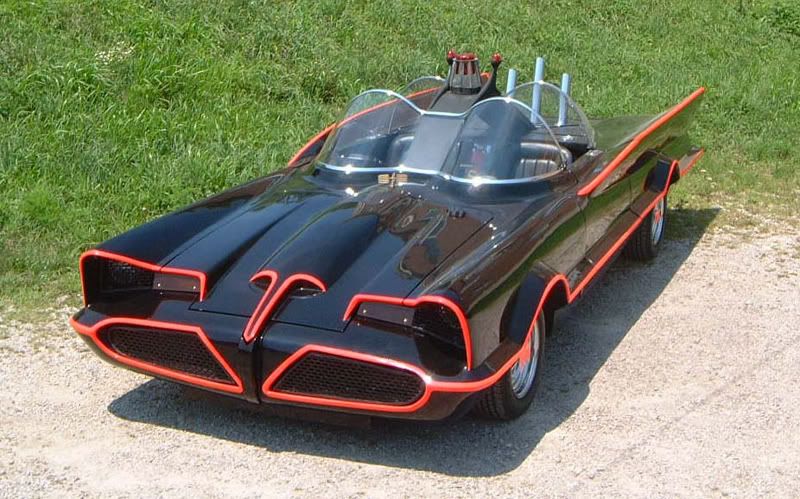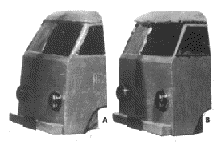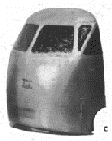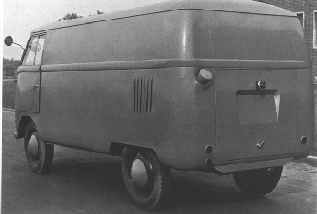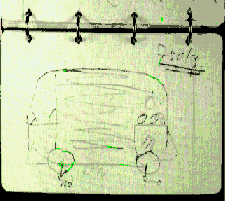
 The sketch of Ben Pon at April 23th 1947. The sketch of Ben Pon at April 23th 1947.

| At Wednesday 23rd of April has Ben Pon at meeting with the British. He talks through his ideas about the import of Volkswagens in the Netherlands. But this a special day, as he does something else. He takes his notebook and he makes a drawing of a oblong transport vehicle. As matter of fact it is not more then a soapbox on wheels, in front, the cab and in the back, the engine. How his conversation ends with the British nobody knows. But one thing is for sure. For his time, 1947, his idea is revolutionary. It is brilliantly simple, a large cargo space in a small area. According to Pon, the vehicle has a weight of 750 kilos and the with the cargo being easily 750 kilos as well. Pon´s based his design on the so-called Plattenwagen. A primitive vehicle, the Plattenwagen looks like a push bike with a Moped engine. The Volkswagen engineers had designed it for internal factory transportation at the Volkswagen plant. Like the Plattenwagen his design must be built on the chassis of a beetle.
 The Plattenwagen The Plattenwagen
|
A blueprint for the future.
 |  One of the first sketches, design of the Transporter (side- and overhead views). This design is of the rectangular cabin. One of the first sketches, design of the Transporter (side- and overhead views). This design is of the rectangular cabin. |
At first, Pon's brilliant idea is left alone. But not for long. A year later ( Ben Pon and his brother Wijnand became the first official Volkswagen-importers of the world) Pon received a message from Volkswagen . Heinrich Nordhoff, the new chief of Volkswagen, and the technical manager Alfred Haesner, had decided to developed Ben Pon´s idea. Heinrich Nordhoff and Alfred Haesner consent to the development of Typ 29. And so Ben Pon became the inventor of the Volkswagen Transporter. His simple design of a transport-van is the blueprint for the future. Until 1990 his design can be seen in all Volkswagen Transporters.
Full speed ahead..
Volkswagen is rushing, in November of 1948, to develop the Typ 29 transportwagen They are busy drawing, welding and bolting. After about one year, the two cabins are finished. They resemble each other, in that they are angular of pieces of welded tin. The cabins have no curvature at all. This is due to limitations in the manufacturing capabilities. It is a lot easier for the developers to work with curvatures than it is for the production facilities. The first scale model of Typ 29, both models, is tested in the wind tunnel of the technical high school at Braunschweig with poor results. The wind resistance is much to high, and there are unwanted aerodynamic side effects. But the high school of Braunschweig has a third proposal to offer. A ascetically pleasing rounded cab which tapers into a cargo area. The air resistance is about 40% better then the original design ! This final cabin is used for the full scale prototype.
Changing of cource
The first prototype is built on a existing Volkswagen passenger vehicle. Naturally, this is the VW Beetle. With the installation of the beetle engine, the prototype typ 29 takes his first ride. Unfortunately the chassis of the beetle is to weak for the heavy typ 29 body. unthinkable what will happen with a full cargo load! It is April 1949, but in spite of this setback, work by Volkswagen the factory is continues. |   A small scale model of the transporter with a rounded cabin is successfully tested in the wind tunnel. A small scale model of the transporter with a rounded cabin is successfully tested in the wind tunnel. |
|
It is even stronger, the Volkswagen factory targets production of typ 29 by the early fifties. The course is changing completely. They decide to develop a brand new chassis for the typ 29, a so called "self-carried" chassis is unique for it's time. This was the start of the passenger car and vans division. They are working hard on the brand new typ 29. After testing, the brakes and the steering mechanism are improved, and the engine compartment became smaller. This means that there is more cargo space !
|
|
 This is the prototype from 1949. This is the prototype from 1949.  There is a windshield wiper for the driver only, and the passenger doors do not fit well. The transporter is built on a beetle-chassis which is not sufficient. Volkswagen decides to build a new chassis as quick as possible. This is the so called "self floating chassis". There is a windshield wiper for the driver only, and the passenger doors do not fit well. The transporter is built on a beetle-chassis which is not sufficient. Volkswagen decides to build a new chassis as quick as possible. This is the so called "self floating chassis". |
Everything but a name.
The typ 29 is almost finished. The austerely technical managing director says in October 1949 about the typ 29: "It is a van with a lot of possibilities. It is maneuverable it has enough power uphill, it is has low cost in use and maintenance. It is easy to load and reliable in summer and winter. It is a real Volkswagen...... A universal company van able to transport cargo everywhere in the world." The only thing missing for Volkswagens first transporter is a name. All names like Bulli and Juwel are owned by patent in Berlin. When the first production transporter was ready it's name is simply, "type 2". Seeing that type 1 is the beetle. Later generations of type 2 until 1990 are named T1, T2 ,T3 and T4, but commonly referred to as "transporter". Not until 1990 did the name transporter become officially registered. Briefly; At Volkswagen, November 1949, the bus is introduced to the press it has everything except a name. But it's name is soon to come......
 | Volkswagen-managing director Heinrich Nordhoff during a press conference at 1949:
"Finally the focus was not on the actual chassis, but on cargo space. In front of the cargo floor is the drivers seat, behind the cargo floor is the engine. The point of departure is clear and without compromise. Only this car has his cargo floor exactly between the axles. The pressure on the axles is always the same, it doesn´t matter if the car is loaded or not." |
